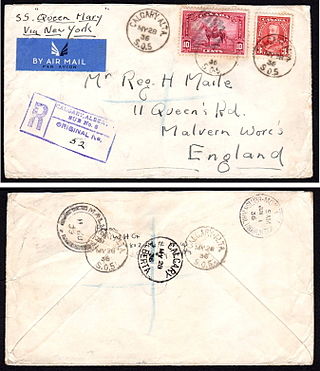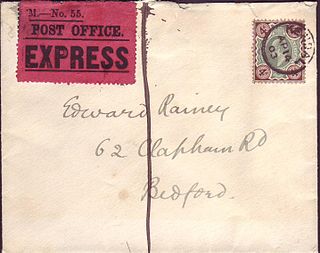
The International Standard Book Number (ISBN) is a numeric commercial book identifier that is intended to be unique. Publishers purchase or receive ISBNs from an affiliate of the International ISBN Agency.

The Universal Product Code is a barcode symbology that is used worldwide for tracking trade items in stores.
Canada Post Corporation, trading as Canada Post, is a Canadian Crown corporation that functions as the primary postal operator in Canada.

An International Standard Serial Number (ISSN) is an eight-digit serial number used to uniquely identify a serial publication (periodical), such as a magazine. The ISSN is especially helpful in distinguishing between serials with the same title. ISSNs are used in ordering, cataloging, interlibrary loans, and other practices in connection with serial literature.

Code 39 is a variable length, discrete barcode symbology defined in ISO/IEC 16388:2007.

Registered mail is a postal service in many countries which allows the sender proof of mailing via a receipt and, upon request, electronic verification that an article was delivered or that a delivery attempt was made. Depending on the country, additional services may also be available, such as:
POSTNET is a barcode symbology used by the United States Postal Service to assist in directing mail. The ZIP Code or ZIP+4 code is encoded in half- and full-height bars. Most often, the delivery point is added, usually being the last two digits of the address or PO box number.
A check digit is a form of redundancy check used for error detection on identification numbers, such as bank account numbers, which are used in an application where they will at least sometimes be input manually. It is analogous to a binary parity bit used to check for errors in computer-generated data. It consists of one or more digits computed by an algorithm from the other digits in the sequence input.
In computer programming, a function object is a construct allowing an object to be invoked or called as if it were an ordinary function, usually with the same syntax. In some languages, particularly C++, function objects are often called functors.

In cryptography, XTEA is a block cipher designed to correct weaknesses in TEA. The cipher's designers were David Wheeler and Roger Needham of the Cambridge Computer Laboratory, and the algorithm was presented in an unpublished technical report in 1997. It is not subject to any patents.
SEDOL stands for Stock Exchange Daily Official List, a list of security identifiers used in the United Kingdom and Ireland for clearing purposes. The numbers are assigned by the London Stock Exchange, on request by the security issuer. SEDOLs serve as the National Securities Identifying Number for all securities issued in the United Kingdom and are therefore part of the security's International Securities Identification Number (ISIN) as well. The SEDOL Masterfile (SMF) provides reference data on millions of global multi-asset securities each uniquely identified at the market level using a universal SEDOL code.

MaxiCode is a public domain, machine-readable symbol system originally created by the United Parcel Service (UPS) in 1992. Suitable for tracking and managing the shipment of packages, it resembles an Aztec Code or QR code, but uses dots arranged in a hexagonal grid instead of square grid. MaxiCode has been standardised under ISO/IEC 16023.

An address is a collection of information, presented in a mostly fixed format, used to give the location of a building, apartment, or other structure or a plot of land, generally using political boundaries and street names as references, along with other identifiers such as house or apartment numbers and organization name. Some addresses also contain special codes, such as a postal code, to make identification easier and aid in the routing of mail.
In some programming languages, const is a type qualifier that indicates that the data is read-only. While this can be used to declare constants, const in the C family of languages differs from similar constructs in other languages in that it is part of the type, and thus has complicated behavior when combined with pointers, references, composite data types, and type-checking. In other languages, the data is not in a single memory location, but copied at compile time for each use. Languages which use it include C, C++, D, JavaScript, Julia, and Rust.

Express mail is an expedited mail delivery service for which the customer pays a premium for faster delivery. Express mail is a service for domestic and international mail, and is in most nations governed by the country's own postal administration. Since 1999, the international express delivery services are governed by the EMS Cooperative.

The International Article Number is a standard describing a barcode symbology and numbering system used in global trade to identify a specific retail product type, in a specific packaging configuration, from a specific manufacturer. The standard has been subsumed in the Global Trade Item Number standard from the GS1 organization; the same numbers can be referred to as GTINs and can be encoded in other barcode symbologies, defined by GS1. EAN barcodes are used worldwide for lookup at retail point of sale, but can also be used as numbers for other purposes such as wholesale ordering or accounting. These barcodes only represent the digits 0–9, unlike some other barcode symbologies which can represent additional characters.
In number theory, a narcissistic number in a given number base is a number that is the sum of its own digits each raised to the power of the number of digits.
A negative base may be used to construct a non-standard positional numeral system. Like other place-value systems, each position holds multiples of the appropriate power of the system's base; but that base is negative—that is to say, the base b is equal to −r for some natural number r.

The Intelligent Mail Barcode (IMb) is a 65-bar barcode for use on mail in the United States. The term "Intelligent Mail" refers to services offered by the United States Postal Service for domestic mail delivery. The IM barcode is intended to provide greater information and functionality than its predecessors POSTNET and PLANET. An Intelligent Mail barcode has also been referred to as a One Code Solution and a 4-State Customer Barcode, abbreviated 4CB, 4-CB or USPS4CB. The complete specification can be found in USPS Document USPS-B-3200. It effectively incorporates the routing ZIP Code and tracking information included in previously used postal barcode standards.
Tracking numbers are numbers assigned to packages when they are shipped. Tracking numbers are useful for knowing the location of time sensitive deliveries. It is a unique ID number or code assigned to a package or parcel. The tracking number is typically printed on the shipping label as a bar code that can be scanned by anyone with a bar code reader or smartphone.











